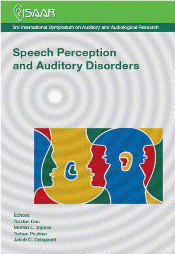Sources of decoding errors of the perceptual cues, in normal and hearing impaired ears
Abstract
After many decades of work it is not understood how the average normal- hearing (NH) ears, or significantly hearing-impaired (HI) ears, decode con- sonants. We wish to discover the strategy HI persons use to recognize consonants in a consonant-vowel (CV) context. To understand how NH ears decode consonants, we have repeated the classic consonant perception experiments of Fletcher, French and Steinberg, G.A. Miller, Furui, and others. This has given us access to the raw data (e.g., to allow for ANOVA testing) and the ability to verify many widely held (typically wrong) assumptions. The first lesson of this research is the sin of averaging: While audiology is built on average measures, most of the interesting information is lost in these averages. It has been shown, for example, that averaging across consonants is a grievous error, as is averaging across talkers for a given consonant. It will be shown how an average entropy measure (a measure of dispersion in probability) has higher utility than the average error.
References
Allen, J.B., and Rabiner, L.R. (1977). “A unified approach to short-time Fourier analysis and synthesis,” Proc. IEEE, 65, 1558-1564.
Allen, J.B. (1994). “How do humans process and recognize speech?” IEEE T. Speech Audio P., 2, 567-577.
Allen, J.B. (1996). “Harvey Fletcher’s role in the creation of communication acoustics,” J. Acoust. Soc. Am., 99, 1825-1839.
Allen, J.B. (2003). “Amplitude compression in hearing aids,” in MIT Encyclopedia of Communication Disorders. Edited by R. Kent (MIT Press, MIT, Boston, MA), Chapter IV, pp. 413-423.
Allen, J.B. (2004). “The articulation index is a Shannon channel capacity,” in Auditory signal processing: physiology, psychoacoustics, and models. Edited by D. Pressnitzer, A. de Cheveigne ́, S. McAdams, and L. Collet (Springer Verlag, New York, NY), Chapter Speech, pp. 314-320.
Allen, J.B. (2005). Articulation and Intelligibility (Morgan and Claypool, 3401 Buckskin Trail, LaPorte, CO 80535), ISBN: 1598290088.
Allen, J.B. (2008). “Nonlinear cochlear signal processing and masking in speech perception,” in Springer Handbook on speech processing and speech commu- nication. Edited by J. Benesty and M. Sondhi (Springer, Heidelberg Germany), Chapter 3, pp. 1-36.
Allen, J.B., and Li, F. (2009). “Speech perception and cochlear signal processing,” IEEE Signal Proc. Mag., 26, 73-77.
Allen, J.B., Re ́gnier, M., Phatak, S., and Li, F. (2009). “Nonlinear cochlear signal processing and phoneme perception”, in Proceedings of the 10th Mechanics of Hearing Workshop. Edited by N.P. Cooper and D.T. Kemp (World Scientific Publishing Co., Singapore), pp. 93-105.
Blumstein, S.E., Stevens, K.N., and Nigro, G.N. (1977). “Property detectors for bursts and transitions in speech perceptions,” J. Acoust. Soc. Am., 61, 1301-1313.
Campbell, G.A. (1910). “Telephonic intelligibility,” Phil. Mag., 19, 152-159.
Cole, R., and Scott, B. (1974). “Toward a theory of speech perception,” Psychol. Rev., 81, 348-374.
Dorman, M., Studdert-Kennedy, M., and Raphael, L. (1977). “Stop-consonant recognition: Release bursts and formant transitions as functionlly equivialent, contextdependent cues,”, Percept. Psychophys., 22, 109-122.
Fletcher, H. (1921). “An empirical theory of telephone quality,” AT&T Internal Memorandum, 101.
Fletcher, H. (1922). “The nature of speech and its interpretation,” J. Franklin Inst., 193, 729-747.
Fletcher, H., and Galt, R. (1950). “Perception of speech and its relation to telephony,” J. Acoust. Soc. Am., 22, 89-151.
Fousek, P., Svojanovsky, P., Grezl, F., and Hermansky, H. (2004). “New nonsense syllables database – analyses and preliminary ASR experiments,” Proceedings of International Conference on Spoken-Language Processing (ICSLP).
Furui, S. (1986). “On the role of spectral transition for speech perception,” J. Acoust. Soc. Am., 80, 1016-1025.
Han, W. (2011). Methods for robust characterization of consonant perception in hearing-impaired listeners, Ph.D. thesis, University of Illinois at Urbana-Champaign.
Kapoor, A., and Allen, J.B. (2012). “Perceptual effects of plosive feature modification,” J. Acoust. Soc. Am., 131, 478-491.
Li, F., and Allen, J.B. (2009). “Additivity law of frequency integration for consonant identification in white noise,” J. Acoust. Soc. Am., 126, 347-353.
Li, F., Menon, A., and Allen, J.B. (2010). “A psychoacoustic method to find the perceptual cues of stop consonants in natural speech,” J. Acoust. Soc. Am., 127, 2599-2610.
Li, F., and Allen, J.B. (2011). “Manipulation of consonants in natural speech,” IEEE T. Audio Speech, 19, 496-504.
Miller, G.A., and Nicely, P.E. (1955). “An analysis of perceptual confsions among some english consonants,” J. Acoust. Soc. Am., 27, 338-352.
Phatak, S., and Allen, J.B. (2007). “Consonant and vowel confusions in speech-weighted noise,” J. Acoust. Soc. Am., 121, 2312-2326.
Phatak, S., Lovitt, A., and Allen, J.B. (2008). “Consonant confusions in white noise,” J. Acoust. Soc. Am., 124, 1220-1233.
Phatak, S.A., Yoon, Y., Gooler, D.M., and Allen, J.B. (2009). “Consonant loss profiles in hearing impaired listeners,” J. Acoust. Soc. Am., 126, 2683-2694.
Additional Files
Published
How to Cite
Issue
Section
License
Authors who publish with this journal agree to the following terms:
a. Authors retain copyright* and grant the journal right of first publication with the work simultaneously licensed under a Creative Commons Attribution License that allows others to share the work with an acknowledgement of the work's authorship and initial publication in this journal.
b. Authors are able to enter into separate, additional contractual arrangements for the non-exclusive distribution of the journal's published version of the work (e.g., post it to an institutional repository or publish it in a book), with an acknowledgement of its initial publication in this journal.
c. Authors are permitted and encouraged to post their work online (e.g., in institutional repositories or on their website) prior to and during the submission process, as it can lead to productive exchanges, as well as earlier and greater citation of published work (See The Effect of Open Access).
*From the 2017 issue onward. The Danavox Jubilee Foundation owns the copyright of all articles published in the 1969-2015 issues. However, authors are still allowed to share the work with an acknowledgement of the work's authorship and initial publication in this journal.


